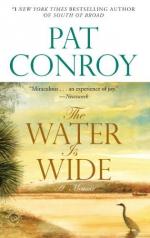|
This section contains 415 words (approx. 2 pages at 400 words per page) |

|
The general form of The Water Is Wide is that of the autobiography. The novel is told in first person, with the author as the narrator; he also identifies himself as the main character. The novel might more firmly be placed within the tradition of "memoir," as it covers less than two years of the author's experiences. The first-person approach creates a limited point of view, but that works well for this particular novel, in which exist the parallel themes of academic education of the children, and social and political education for the author. Although the main character is not a child, the novel could still be classified as a coming-ofage novel, in which the narrator learns through bitter experience the realities of a world directed by superstition, prejudice and ignorance.
Conroy seems to present an honest picture of his efforts, emphasizing the self-aggrandizing aspects of his personality...
|
This section contains 415 words (approx. 2 pages at 400 words per page) |

|




